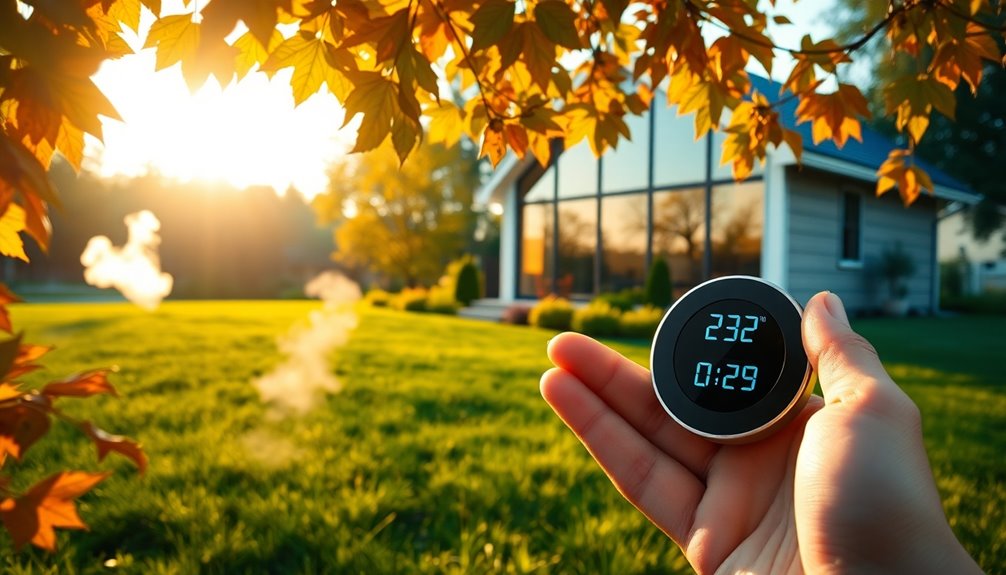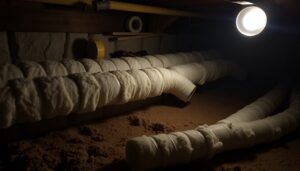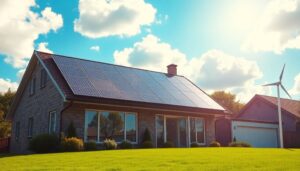To save money while heating with geothermal systems, focus on proper insulation and regular maintenance. Confirm your home is well-insulated to minimize heat loss, boosting your system's efficiency. Schedule annual professional inspections and change air filters every 1-3 months to keep things running smoothly. Utilizing programmable thermostats can further optimize your settings, potentially saving you an additional 15% on heating costs. Don't forget about federal tax credits and local rebates that can offset installation costs. By implementing these strategies, you'll maximize your savings. Keep exploring to uncover more tips for enhancing your geothermal heating experience.
Understanding Geothermal Heat Pumps
Geothermal heat pumps work by transferring heat between your home and the ground, making them a highly efficient option for both heating and cooling. These systems use underground pipes to tap into the Earth's stable underground temperature, which averages around 55°F. This allows geothermal heat pumps to be 3-4 times more energy-efficient in heating mode compared to traditional air-source heat pumps.
By utilizing this stable temperature, you can considerably save money on your utility bills. The EPA reports that homeowners can see heating cost reductions of 30-70% and cooling cost reductions of 20-50%. Not only do these systems lower your monthly expenses, but they also have a long lifespan, with indoor heat pumps lasting over 20 years and buried loops often exceeding 50 years. Additionally, opting for sustainable delivery practices when purchasing a geothermal system can further enhance your eco-friendly initiatives. Furthermore, these systems actively reduce carbon emissions through sustainable practices, contributing to a healthier planet. Regular maintenance and monitoring of your system will ensure it continues to operate at optimal efficiency, further maximizing your savings.
This longevity minimizes long-term repair and replacement costs, further enhancing your savings.
However, it's vital to conduct a proper site assessment to verify your location has suitable soil conditions and a ground or water source within 30 feet. This step is fundamental for implementing geothermal heat pumps effectively and maximizing your potential savings.
Advantages of Geothermal Heating
When considering energy-efficient heating options, the advantages of geothermal heating systems become clear. These systems can save you between 30-70% on heating costs compared to traditional systems, according to the EPA. By utilizing the stable underground temperature of around 55°F, geothermal systems operate 3-4 times more efficiently than air-source heat pumps. This efficiency translates into significant Long-Term Savings on your utility bills. Additionally, implementing a solid budgeting strategy can help you maximize your savings from these systems. Budget apps can assist in tracking these savings and ensuring that your financial goals are met effectively.
Moreover, you won't have to worry about frequent replacements. Indoor heat pumps can last over 20 years, while buried loops may exceed 50 years, further contributing to your cost savings.
Plus, geothermal systems emit no greenhouse gases, which not only decreases your carbon footprint but also supports sustainable energy practices that are better for the environment.
In addition to financial benefits, geothermal heating provides consistent temperature control year-round, ensuring your home remains comfortable regardless of the season. This system exemplifies sustainable energy practices, highlighting how modern technology can lead to eco-friendly solutions.
The combination of energy efficiency and longevity makes geothermal systems an excellent investment for homeowners looking to save money while also caring for the planet.
Adopting geothermal heating is a smart choice that pays off both now and in the future.
Cost Savings Overview
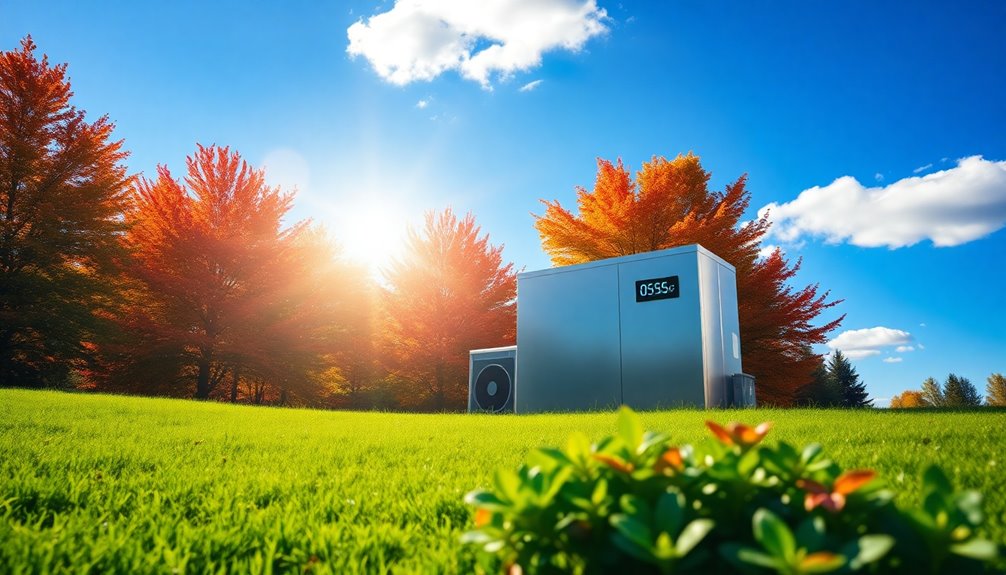
By making the switch to geothermal systems, you could see substantial savings on your energy bills. These systems can cut your heating costs by 30-70% compared to traditional methods, which means lower overall energy expenses for you.
The U.S. Department of Energy highlights that geothermal heat pumps are 3-4 times more energy-efficient in heating mode than conventional air-source heat pumps, making them a smart investment. Additionally, utilizing budgeting apps can help you effectively allocate the savings from lower heating costs towards future financial goals. Furthermore, using budgeting tools can provide insights into how to best utilize your savings for long-term financial success.
On average, homeowners can save up to $1,500 annually by opting for geothermal heating systems. This significant reduction in operational costs can really add up over the years.
One of the key reasons for this efficiency is that geothermal systems maintain a stable indoor temperature by utilizing the earth's constant temperature of about 55°F. This approach enhances heating efficiency and reduces energy consumption, allowing you to save money in the long run.
Furthermore, with proper installation and maintenance, geothermal heat pumps can last over 20 years. This longevity minimizes replacement and repair costs, providing even more financial peace of mind.
Additionally, using automated investment management tools can help you channel your savings from lower heating costs into effective financial growth strategies. Making the switch to geothermal heating isn't just eco-friendly; it's also a savvy way to manage your household expenses.
Evaluating System Suitability
Evaluating the suitability of a geothermal system for your home is essential to maximizing its benefits. Start by examining local geological conditions; you'll need to confirm you're within 30 feet of a ground or water source and that your soil is thick and mineral-rich for effective system installation. Additionally, consider the integration capabilities of your geothermal system with other technologies to ensure optimized efficiency. The effectiveness of your system can also be enhanced by utilizing budget management tools that track related expenses throughout the installation process.
Next, conduct a home energy audit to check insulation levels. Areas like uninsulated crawl spaces can lead to heat loss, impacting your geothermal heating and cooling system's performance.
Consider your home's location, too. If you live in a region with cold winters, a geothermal system can efficiently draw warmth from the ground, making it more effective.
Also, think about the size of your home and its energy consumption patterns. Larger homes or those with high energy usage may need a more robust geothermal system to achieve the efficiency you desire.
Finally, look into local incentives and rebates for geothermal systems. These can help offset the initial installation costs and enhance the overall financial viability of your system. Additionally, researching expense management apps can provide valuable insights into managing your installation costs effectively.
Importance of Insulation

Insulation plays an essential role in maximizing the efficiency of your geothermal system.
By properly insulating your home, you can greatly reduce heat loss and improve energy efficiency, leading to lower heating costs. Effective insulation not only enhances your system's performance but also contributes to strategic planning by highlighting cost-saving opportunities. Additionally, effective insulation supports sustainable consumption patterns, helping to reduce overall energy demand and environmental impact. Moreover, implementing automated payment solutions for your utility bills can help you manage costs effectively while ensuring timely payments.
Let's explore how effective insulation can enhance your system's performance and save you money.
Insulation Benefits Overview
A well-insulated home is essential for maximizing the efficiency of geothermal systems and ensuring considerable energy savings. Proper insulation helps to reduce heat loss, allowing your geothermal system to operate more effectively.
Here are four key benefits of effective insulation:
- Reduced Energy Consumption: Insulating your crawl space can prevent up to 30% more energy use, as uninsulated areas considerably contribute to heat loss.
- Cost Savings: A well-insulated attic, ideally with 10-12 inches of insulation, helps maintain indoor temperatures, reducing operational costs for your geothermal system.
- Enhanced Performance: Combining well-insulated walls and ceilings can lead to savings of up to 50% on heating costs, improving the overall performance of your geothermal system.
- Longevity of Equipment: Effective insulation reduces the workload on your heat pump, promoting the longevity and efficiency of your geothermal system.
Improving Energy Efficiency
Maximizing energy efficiency in your home goes hand in hand with effective insulation. Proper insulation markedly reduces heat loss, which is essential when you're using geothermal systems. By insulating crawl spaces and attics, you can prevent drafts and heat escape, ensuring the consistent indoor temperatures that geothermal systems are designed to provide.
The U.S. Department of Energy recommends a minimum of R-38 insulation in attics to achieve ideal energy savings. This level of insulation helps maintain the efficiency of your geothermal heating system. A well-insulated home can boost the performance of geothermal heat pumps, yielding up to 30% more energy efficiency during heating seasons.
Regularly evaluating and upgrading insulation not only enhances comfort but can also lead to considerable long-term savings on utility bills. This complements the benefits of geothermal heating systems perfectly.
Monitoring Energy Consumption
To save money with your geothermal system, tracking energy usage is essential.
By identifying inefficiencies promptly, you can make necessary adjustments that cut costs.
Using monitoring devices helps you stay on top of your energy consumption and maximize your savings.
Track Energy Usage
Monitoring energy consumption is key to unblocking savings with geothermal systems. By actively tracking energy usage, you can make informed decisions that lead to significant cost reductions over time.
Here are four effective strategies to help you stay on top of your energy consumption:
- Use Monitoring Devices: Tools like KillAWatt can help you identify energy consumption patterns, pinpointing high-usage appliances.
- Track Circuit Usage: Systems like Plugged Solar or TED allow you to monitor energy usage on a circuit basis, giving insights into individual circuits.
- Measure Major Appliances: Regularly measuring energy consumption for major appliances can uncover hidden inefficiencies, leading to savings on your utility bills.
- Adjust for Fluctuations: Engaging in energy monitoring reveals daily usage fluctuations, enabling you to adjust your geothermal system settings when you're away or during low demand.
Identify Inefficiencies Promptly
Identifying inefficiencies in your energy consumption can lead to substantial savings with geothermal systems. To effectively manage your heating efficiency, consider installing monitoring devices like KillAWatt. These tools help you track energy usage by circuit, making it easy to identify which appliances consume the most power. You can then adjust your usage accordingly.
Advanced systems such as Plugged Solar or TED allow you to monitor multiple circuits simultaneously, pinpointing inconsistencies in energy consumption. Regular circuit testing is essential, as it can reveal hidden issues like partial shorts that may lead to energy loss without tripping breakers. This guarantees that all systems function efficiently.
Additionally, keeping an eye on your daily energy consumption patterns can help you spot unusual spikes, which may indicate inefficiencies or potential energy theft from neighboring properties. Engaging with your utility company for energy audits can also provide valuable insights.
These audits help identify specific areas for improvement, making sure you can effectively identify inefficiencies promptly and enhance your heating efficiency. By staying proactive with monitoring, you'll optimize your geothermal system and save money in the long run.
Maintenance Best Practices
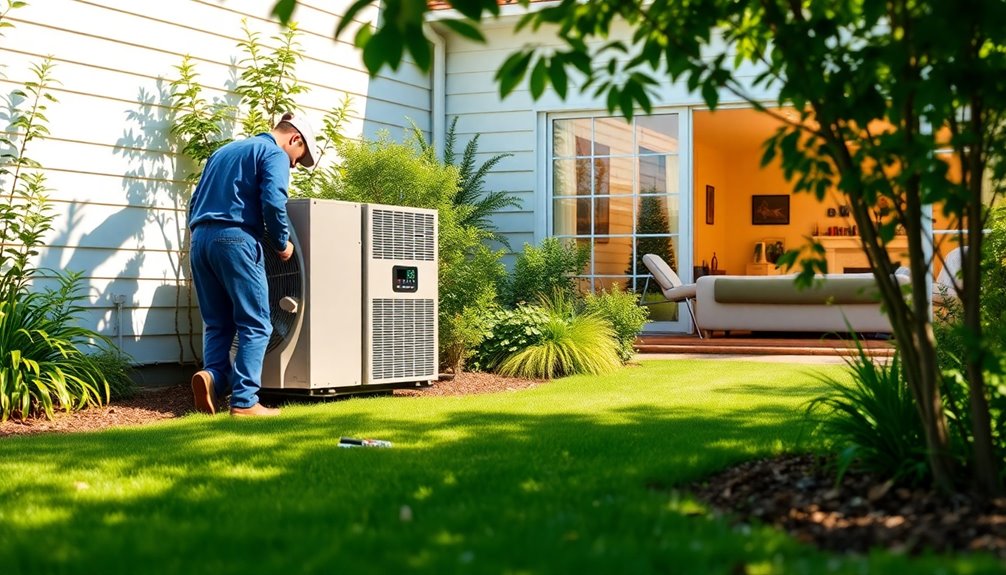
Maintaining your geothermal system is essential for maximizing its efficiency and longevity. By following these maintenance best practices, you can guarantee your system runs smoothly and saves you money over time:
- Change or clean air filters every 1-3 months to improve airflow and efficiency, potentially cutting energy costs by up to 15%.
- Schedule annual professional inspections to spot potential issues early, preventing costly repairs and guaranteeing peak performance.
- Keep the area around the outdoor heat pump clear of debris and vegetation. This guarantees proper airflow and prevents overheating, enhancing system longevity.
- Monitor and maintain proper fluid levels in the ground loop system. Low fluid levels can decrease efficiency and increase energy consumption.
Additionally, make certain your ductwork is properly sealed and insulated.
Leaks can lead to energy losses of up to 30%, greatly impacting your heating costs.
By implementing these practices, you'll not only extend the life of your geothermal system but also enjoy lower energy bills.
Regular maintenance is key to reaping the full benefits of your investment.
Using Programmable Thermostats
Using programmable thermostats can help you optimize your temperature settings and schedule heating patterns effectively.
By adjusting your system according to when you're home or away, you can markedly reduce energy waste.
This simple tool can lead to substantial savings on your heating costs while keeping your home comfortable.
Optimize Temperature Settings
Optimizing temperature settings is essential for maximizing the efficiency of your geothermal system, and programmable thermostats are a game-changer in this regard. By utilizing these devices, you can greatly reduce your energy consumption and save money on heating costs.
Here are four tips to help you get started:
- Adjust for Absences: Lower the thermostat when you're away or asleep, saving about 1% on your heating bill for every degree you reduce it.
- Avoid Drastic Changes: Keep a consistent temperature to enhance your system's efficiency. Sudden shifts can lead to unnecessary energy use.
- Use "Vacation" Mode: Activate this setting when you're away for extended periods to maintain a moderate temperature without wasting energy.
- Seasonal Reviews: Regularly check and adjust your programmable thermostat settings to align with seasonal changes, optimizing your geothermal system's performance.
Schedule Heating Patterns
Scheduling heating patterns effectively can greatly boost the efficiency of your geothermal system. By using a programmable thermostat, you can set specific heating schedules that align with your daily routine, ensuring your home remains comfortable while minimizing energy waste.
For instance, lowering the temperature during non-occupancy hours can lead to a reduction in energy consumption by up to 10% for each degree you decrease the temperature over an eight-hour period.
When you program your thermostat to adjust the temperature based on when you're home or away, you could save as much as 15% on your annual heating costs. Plus, homes equipped with programmable thermostats typically save an average of $180 per year on heating bills.
It's important to remember that geothermal systems work best when indoor temperatures are stable. By scheduling heating patterns that maintain a consistent environment, you not only enhance the comfort of your living space but also maximize the efficiency of your heating system.
Reduce Energy Waste
How can you effectively reduce energy waste in your home? One of the best strategies is using a programmable thermostat. By taking advantage of this technology, you can greatly cut down on unnecessary energy consumption, especially when paired with geothermal systems.
Here are four ways to optimize your thermostat use:
- Set Heating Schedules: Program your thermostat to lower temperatures when you're away or asleep, reducing energy waste by up to 15%.
- Adjust for Peak Times: Set your thermostat to lower temperatures during peak energy usage periods, saving you money during the winter months.
- Monitor in Real-Time: If your geothermal system supports smart thermostats, use them to track and adjust heating based on your daily routines.
- Small Adjustments Matter: Lowering your thermostat by just a few degrees can save an additional 1% for each degree over an 8-hour period.
Exploring Incentives and Rebates
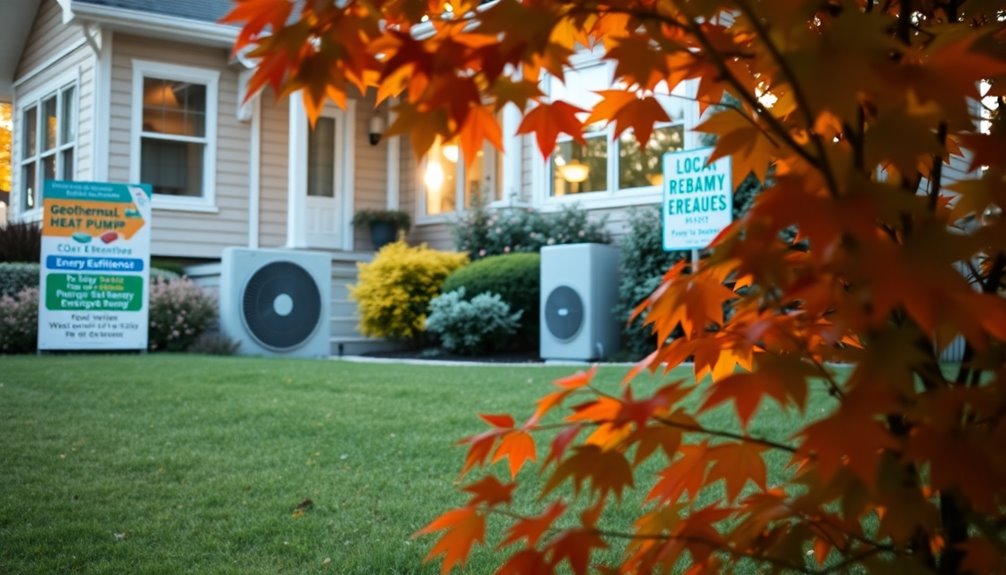
When considering a geothermal system for your home, it's essential to tap into the various incentives and rebates available to you. These financial aids can greatly reduce the cost of your installation.
For starters, many geothermal system installations qualify for federal tax credits of up to 26% of the total cost. This can greatly decrease your upfront investment.
Additionally, local utility companies often provide rebates that range from $1,000 to $5,000, depending on your region and the specific programs they offer. It's worth checking with your utility provider to see what's available.
Some states even offer extra incentives, such as property tax exemptions or sales tax exemptions on geothermal equipment, which further enhances your potential savings.
You might also explore financing options that bundle these incentives and rebates, allowing you to manage your payment plans more comfortably.
Finally, don't overlook green energy grants or loans from government programs aimed at promoting renewable energy usage. By leveraging these incentives and rebates, you can make your geothermal system not just an environmentally friendly choice, but also a financially savvy one.
Enhancing System Efficiency
To truly maximize the savings from your geothermal system, enhancing its efficiency is key. By making a few adjustments and regular checks, you can guarantee your system operates at its best, leading to significant savings on your heating bills.
Here are four effective ways to enhance efficiency:
- Regular Maintenance: Clean filters and check water levels to keep your geothermal system running smoothly. This not only boosts efficiency but also prolongs the unit's lifespan.
- Consistent Temperature Settings: Set your geothermal heat pump to maintain steady temperature levels. This minimizes energy spikes and can save you up to 30% on heating costs.
- Insulate Your Home: Insulating areas like the crawl space minimizes heat loss. This leads to better performance from your geothermal system and lower energy consumption.
- Smart Thermostats: Use smart thermostats to manage your heating schedule effectively. This guarantees your system operates only when necessary, optimizing its efficiency.
Longevity of Geothermal Systems
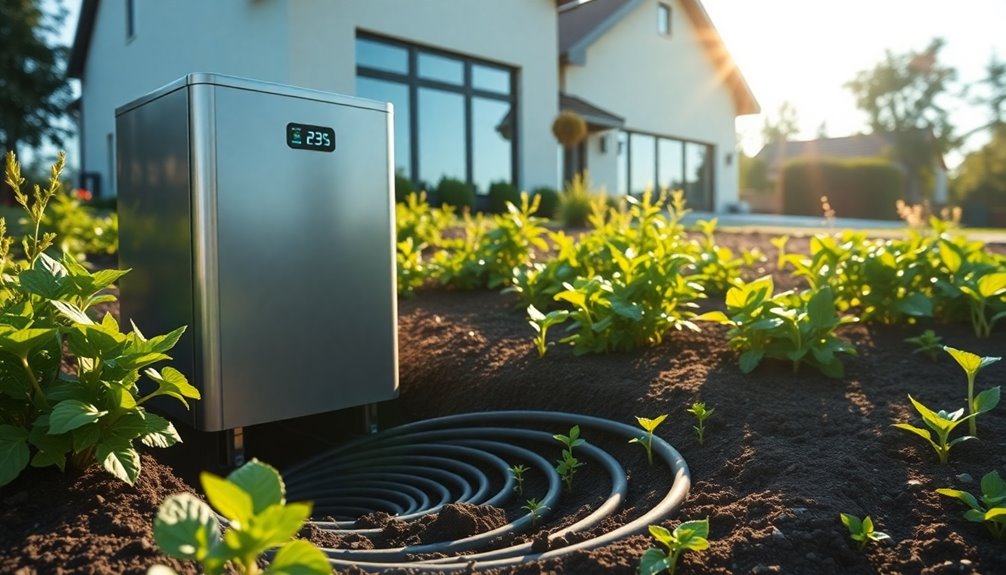
Geothermal systems are designed for the long haul, with indoor heat pumps often lasting over 20 years and buried ground loops exceeding 50 years. This impressive longevity means you won't have to worry about frequent replacements, ultimately saving you money.
The durability of ground-source heat pumps contributes notably to lower long-term repair expenses, making them a cost-effective choice for heating your home.
When you invest in a geothermal system, you're not just purchasing a heating solution; you're securing a reliable and efficient system that maintains consistent performance. With fewer interruptions for repairs and upgrades, your system runs smoothly over the years.
This extended lifespan translates into notable financial savings since you won't be faced with regular maintenance costs associated with shorter-lived systems.
Moreover, the longevity of geothermal systems enhances their overall efficiency. As the components are built to last, you can enjoy uninterrupted heating without the anxiety of unexpected failures.
Comparing Energy Costs
Looking to cut down on your energy bills? Geothermal heating systems offer a compelling alternative to traditional methods. By comparing energy costs, you'll see why many homeowners are making the switch.
Here are four key points to reflect upon:
- Significant Savings: Geothermal systems can reduce your heating costs by 30-70% annually compared to conventional heating methods.
- Energy Efficiency: These systems are 3-4 times more energy-efficient than air-source heat pump systems, thanks to stable underground temperatures.
- Lower Monthly Bills: With geothermal heating, you could save up to $1,500 annually on your monthly utility bills, depending on energy usage and system efficiency.
- Long-term Investment: While the initial installation cost may be higher, the reduced utility bills make geothermal systems a cost-effective long-term investment.
Impact of Insulation Gaps
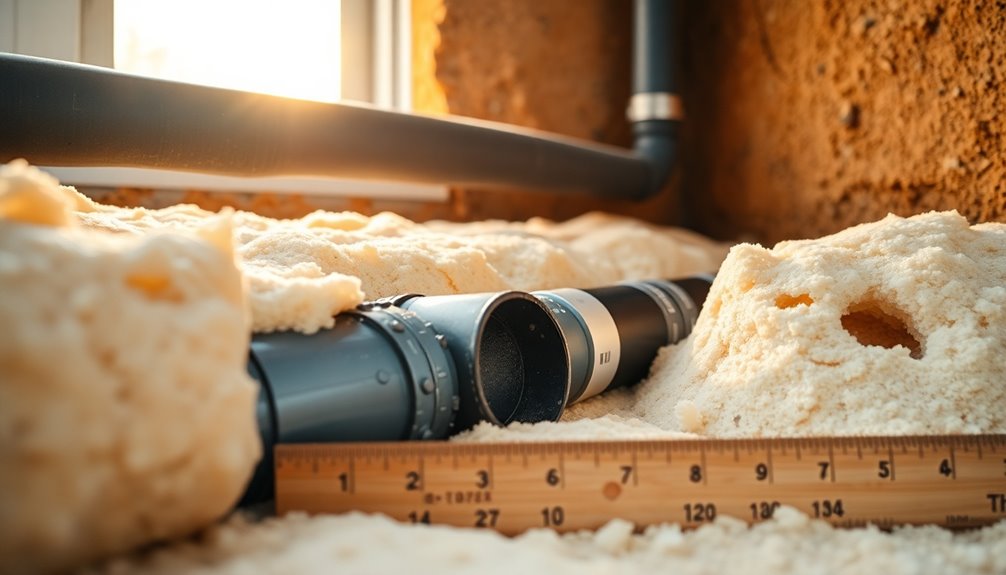
Notable insulation gaps in your home's crawl space can lead to frustrating heat loss and skyrocketing heating costs. If left unaddressed, these gaps can increase your heating costs by 10-20%.
When your home's insulation isn't sealed properly, it compromises the efficiency of your geothermal system, making it work harder to maintain comfortable indoor temperatures. This not only results in higher energy consumption but also contributes to noticeable temperature fluctuations throughout your space.
For peak performance, verify that your attic has 10-12 inches of insulation. This can greatly reduce your heating demands and help your geothermal system operate more efficiently.
By properly addressing insulation gaps, you can maintain stable indoor temperatures, which will lower your reliance on heating and ultimately decrease your utility bills.
Energy audits often reveal the hidden costs of unsealed insulation gaps, highlighting the need for improvements. By sealing these gaps, you could save $200 or more annually on heating costs.
Investing time in insulation can enhance your home's energy efficiency and protect your wallet, confirming that your geothermal system performs at its best while keeping your home comfortable year-round.
Future of Geothermal Heating
As technology advances, geothermal heating systems are becoming more efficient and affordable, opening doors for more homeowners like you.
The market's potential is expanding, driven by the growing demand for sustainable energy solutions.
With these changes on the horizon, you'll find geothermal systems increasingly appealing for your home's heating needs.
Technological Advancements Ahead
The future of geothermal heating is bright, thanks to a wave of technological advancements that promise to make these systems more efficient and cost-effective than ever.
Here are some key innovations you should keep an eye on:
- Improved Heat Exchanger Designs: New designs can boost efficiency by up to 25%, greatly cutting energy consumption and costs.
- Advanced Ground Loop Technology: Enhanced materials and installation techniques can extend system lifespans to over 100 years, minimizing replacement expenses.
- Smart Home Integration: Real-time monitoring and optimization through smart technology can deliver up to 30% additional energy savings for homeowners.
- Hybrid Geothermal Systems: Combining geothermal with solar energy could reduce heating costs by up to 50%, while enhancing overall system efficiency.
These advancements are revolutionizing how geothermal systems operate, making them more accessible and financially viable for you.
With innovations in drilling techniques lowering installation costs by 10-20%, now's the perfect time to evaluate geothermal heating for your home.
Embrace these technologies, and watch your energy bills shrink while enjoying the comfort of a reliable heating system.
Expanding Market Potential
With technological advancements paving the way for greater efficiency and lower costs, the geothermal heating market is set for impressive growth. You can expect an annual increase of over 10% through 2028, driven by rising energy costs and a growing awareness of renewable energy benefits.
Government incentives and tax rebates are also making geothermal installations more accessible and financially attractive, especially for homeowners like you who are seeking energy-efficient solutions.
As new technologies emerge, such as improved heat pump efficiency and innovative installation methods, competition in the geothermal market is heating up. This competition leads to lower costs for consumers, allowing you to invest in an energy-efficient heating system without breaking the bank.
Moreover, a rising emphasis on sustainability is prompting states and municipalities to adopt policies favoring geothermal systems due to their low carbon footprint and significant energy savings potential.
You'll find that the increasing popularity of geothermal systems among homeowners is reflected in the growing availability of services and products. This robust market expansion in both residential and commercial sectors guarantees you'll have plenty of options to evaluate when upgrading your heating system.
Conclusion
To sum up, embracing geothermal heating isn't just a smart financial move; it's a step toward a more sustainable future. By investing in this eco-friendly technology, you're not just saving money; you're nurturing our planet for generations to come. With proper insulation and a well-suited system, you'll find comfort in knowing you've made a choice that benefits both your wallet and the environment. So, let's turn up the heat on savings while keeping our Earth cool.

